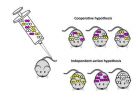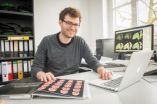(Press-News.org) Research into a recently discovered class of materials shows they have the necessary characteristics to develop ultra-energy efficient electronics. Topological insulators (TI) are three-dimensional materials that conduct electricity on their surfaces, while the interior insulates.
Their surfaces are particularly unique because the motion of the electrons is "protected" by symmetry, meaning electrons will keep moving without scattering even when they encounter defects and contamination.
In fact, electrons on the surface of TIs move so robustly scientists are trying to determine the best way to control or "tune" them in order to use them in next-generation electronics. Until now the only way to change the electronic state was to apply a magnetic or an electric field.
But research led by physicists at the University of Wisconsin-Milwaukee (UWM) has revealed a new method. The team proved that surface conduction on a bismuth selenide TI (Bi2Se3) can be enhanced or destroyed, depending on the kind of stress applied to the material at certain locations, called grain boundaries.
The work was published online March 16 in the journal Nature Physics.
Bi2Se3 is comprised of quintuple atomic layers of bismuth and selenium stacked on top of one another with strong lateral bonds and weak vertical ones between the layers. During its synthesis, when tiny crystalline Bi2Se3 grains coalesce, they form lines of intersection.
These grain boundaries, in which the atoms are either stretched apart or pushed together, can be compared to laying a tile floor starting with randomly placed ceramic pieces, says UWM Physics Professor Lian Li, principal investigator for the National Science Foundation grant supporting the research.
"They do not quite fit together perfectly," says Li, "which produces strain at the joints in the same way as tiles that don't align."
In proximity to a grain boundary where strain exists, the electronic properties on the Bi2Se3 surface are modified. In-plane pulling protects the flow of electrons because the bonds are strong, says Li. Conversely, in-plane compression increases the separation of the quintuple layers, destroying the surface states.
Unraveling the behaviors of TIs is important because it's a promising material for spintronics, an emerging field of nanoscale electronics that involves the manipulation of the electron spin as well as the charge.
By using the orientation of the electron spin, data transfer can be quicker and computing storage capacity increased.
"TIs would work well in spintronics," says Li, "because the spin and velocity of their surface electrons is locked in at right angles."
But first, scientist must find ways to manipulate their behaviors – even to create a simple "on-off" switch.
"So, when we apply compression at the boundaries, then you have no spin movement. All of the sudden, it becomes a switch," says Michael Weinert, UWM Distinguished Professor of Physics and director of the Laboratory for Surface Science. "The advantage here is control. You don't have to apply an electrical field, you can apply stress."
INFORMATION:In addition to Li and Weinert, contributors to the paper include Ying Liu, Yaoyi Li and Shavani Rajput at UWM; Vlado Lazarov, Daniel Gilks, and Leonardo Lari at the University of York, U.K.; and Pedro Luis Galindo at Universidad de Cádiz, Spain.
Pushing and pulling: Using strain to tune a new quantum material
Research finds a new way to control topological insulators
2014-03-21
ELSE PRESS RELEASES FROM THIS DATE:
Computers spot false faces better than people
2014-03-21
TORONTO, ON — A joint study by researchers at the University of California San Diego and the University of Toronto has found that a computer system spots real or faked expressions of pain more accurately than people can. The work, titled "Automatic Decoding of Deceptive Pain Expressions," is published in the latest issue of Current Biology.
"The computer system managed to detect distinctive dynamic features of facial expressions that people missed," said Marian Bartlett, research professor at UC San Diego's Institute for Neural Computation and lead author of the study. ...
Characteristics of lung cancers arising in germline EGFR T790M mutation carriers
2014-03-21
DENVER –Two studies are providing new insight into germline epidermal growth factor receptor (EGFR) T790M mutation in familial non-small cell lung cancer (NSCLC). The findings suggest the need for tailored approaches for early detection and treatment, as well as for genetic testing to identify carriers.
"These studies now solidify the fact that routine clinical management of lung cancer now has to include the awareness of this inherited cancer syndrome," wrote David P. Carbone, MD, PhD, President-Elect of the International Association for the Study of Lung Cancer ...
Ground-improvement methods might protect against earthquakes
2014-03-21
WEST LAFAYETTE, Ind. — Researchers from the University of Texas at Austin's Cockrell School of Engineering are developing ground-improvement methods to help increase the resilience of homes and low-rise structures built on top of soils prone to liquefaction during strong earthquakes.
Findings will help improve the safety of structures in Christchurch and the Canterbury region in New Zealand, which were devastated in 2010 and 2011 by a series of powerful earthquakes. Parts of Christchurch were severely affected by liquefaction, in which water-saturated soil temporarily ...
Forests crucial to green growth
2014-03-21
NAIROBI, Kenya (21 March 2014) ----The value of forests and tree-based ecosystems extends far beyond carbon sequestration; they are the foundation of sustainable societies.
A new report, launched in Jakarta, Indonesia on 21 March - the International Day of Forests – promotes REDD+ and the Green Economy as together providing a new pathway to sustainable development that can benefit all nations. It claims this approach can conserve and even boost the economic and social benefits forests provide to human society.
Building Natural Capital – How REDD+ Can Support a Green ...
Pathogens in cheese
2014-03-21
Listeria is a rod-shaped bacterium highly prevalent in the environment and generally not a threat to human health. One species however, Listeria monocytogenes, can cause listeriosis, a very dangerous disease. This pathogen can be present in raw milk and soft cheeses, smoked fish, raw meat and ready-to-eat products. In Austria, health care providers are required to report all cases of listeriosis, which can be fatal particularly for patients with weakened immune systems. In 2009 and 2010, a dairy in Hartberg (Styria, Austria) produced Quargel cheese contaminated with Listeria ...
In rats, diffuse brain damage can occur with no signs of 'concussion,' reports study in Neurosurgery
2014-03-21
Philadelphia, Pa. (March 21, 2014) – A standard experimental model of concussion in rats causes substantial brain damage—but no behavioral changes comparable to those seen in patients with concussion, reports a study in the April issue of Neurosurgery, official journal of the Congress of Neurological Surgeons. The journal is published by Lippincott Williams & Wilkins, a part of Wolters Kluwer Health.
The results highlight the "disconnect" between preclinical and clinical studies of concussion, according to the report by Dr. Charles L. Rosen of West Virginia University, ...
Genetic evidence for single bacteria cause of sepsis identified for the first time
2014-03-21
An international team of academics, including Professor Marco Oggioni from the University of Leicester's Department of Genetics, has studied how localised infections can turn into the dangerous systematic disease sepsis – and has identified for the first time through genetic evidence that a single bacteria could be the cause.
The study, which has been published in the academic journal PLOS Pathogens, examined the events that lead to sepsis by Streptococcus pneumoniae (pneumococcus), a major human pathogen, in mice. They found that in most cases the bacteria causing sepsis ...
Lightweight construction materials of highest stability thanks to their microarchitecture
2014-03-21
This news release is available in German. KIT researchers have developed microstructured lightweight construction materials of highest stability. Although their density is below that of water, their stability relative to their weight exceeds that of massive materials, such as high-performance steel or aluminum. The lightweight construction materials are inspired by the framework structure of bones and the shell structure of the bees' honeycombs. The results are now presented in the journal PNAS, DOI: 10.1073/pnas.1315147111.
"The novel lightweight construction materials ...
New method can diagnose a feared form of cancer
2014-03-21
The poor prognosis for pancreatic cancer, where only 5 percent of the patients survive five years after the diagnosis, is due to the fact that the tumors often develop unnoticed, and rarely cause symptoms until they have spread to other organs. Recent studies, however, have shown that fluid-filled compartments in the pancreas, called cysts, may be precursors of the cancer.
Cysts in the pancreas, which are found in every 10th person above the age of 70, and are also common in younger people, can be discovered with computed tomography (CT) or magnetic resonance imaging ...
Genetic factor contributes to forgetfulness
2014-03-21
Misplaced your keys? Can't remember someone's name? Didn't notice the stop sign? Those who frequently experience such cognitive lapses now have an explanation. Psychologists from the University of Bonn have found a connection between such everyday lapses and the DRD2 gene. Those who have a certain variant of this gene are more easily distracted and experience a significantly higher incidence of lapses due to a lack of attention. The scientific team will probably report their results in the May issue of "Neuroscience Letters," which is already available online in advance.
Most ...
LAST 30 PRESS RELEASES:
Making lighter work of calculating fluid and heat flow
Normalizing blood sugar can halve heart attack risk
Lowering blood sugar cuts heart attack risk in people with prediabetes
Study links genetic variants to risk of blinding eye disease in premature infants
Non-opioid ‘pain sponge’ therapy halts cartilage degeneration and relieves chronic pain
AI can pick up cultural values by mimicking how kids learn
China’s ecological redlines offer fast track to 30 x 30 global conservation goal
Invisible indoor threats: emerging household contaminants and their growing risks to human health
Adding antibody treatment to chemo boosts outcomes for children with rare cancer
Germline pathogenic variants among women without a history of breast cancer
Tanning beds triple melanoma risk, potentially causing broad DNA damage
Unique bond identified as key to viral infection speed
Indoor tanning makes youthful skin much older on a genetic level
Mouse model sheds new light on the causes and potential solutions to human GI problems linked to muscular dystrophy
The Journal of Nuclear Medicine ahead-of-print tip sheet: December 12, 2025
Smarter tools for peering into the microscopic world
Applications open for funding to conduct research in the Kinsey Institute archives
Global measure underestimates the severity of food insecurity
Child survivors of critical illness are missing out on timely follow up care
Risk-based vs annual breast cancer screening / the WISDOM randomized clinical trial
University of Toronto launches Electric Vehicle Innovation Ontario to accelerate advanced EV technologies and build Canada’s innovation advantage
Early relapse predicts poor outcomes in aggressive blood cancer
American College of Lifestyle Medicine applauds two CMS models aligned with lifestyle medicine practice and reimbursement
Clinical trial finds cannabis use not a barrier to quitting nicotine vaping
Supplemental nutrition assistance program policies and food insecurity
Switching immune cells to “night mode” could limit damage after a heart attack, study suggests
URI-based Global RIghts Project report spotlights continued troubling trends in worldwide inhumane treatment
Neutrophils are less aggressive at night, explaining why nighttime heart attacks cause less damage than daytime events
Menopausal hormone therapy may not pose breast cancer risk for women with BRCA mutations
Mobile health tool may improve quality of life for adolescent and young adult breast cancer survivors
[Press-News.org] Pushing and pulling: Using strain to tune a new quantum materialResearch finds a new way to control topological insulators





